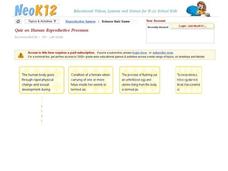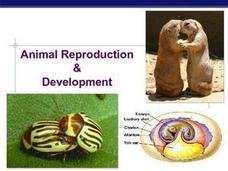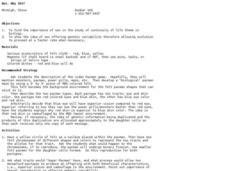Curated OER
Human Embryo Development and Birth Defects
Open this lesson with a discussion on birth defects. Break the class into groups to visit a website and learn about what happens at each stage of human embryo and fetal development. Assign each group a particular birth defect to...
Curated OER
Contraception, Day 1: Overview
Students identify and categorize contraceptive methods according to how they work. They read reference sheets, view and discuss transparencies, and complete various worksheets.
Curated OER
Introduction to Plant Reproduction
Eight objectives pertaining to plant reproduction are stated and addressed in this presentation. Objectives include defining sexual and asexual reproduction, comparing monocots to dicots, explaining flower types, and more. Some of the...
Curated OER
Anatomy and Physiology
Fifth graders work in teams to play a game enabling them to identify the basic components of the female human reproductive system. They view an overhead that describes menstruation and discuss their knowledge of the female reproductive...
Curated OER
AP: Chapter 13: Meiosis and Sexual Life Cycles
Biology learners highlight the features of asexual and sexual reproduction in this life cycle worksheet. They take an in-depth look at the role of chromosomes in meiosis and the overall process of reproduction.
Curated OER
Reproduction, Day 3: Parenthood
Teenagers explain the process from making the decision to have a baby to parenthood. They identify the positive and negative aspects of parenting. In small groups, they browse catalogs of baby equipment and evaluate the cost of...
Curated OER
Human Reproductive Processes Quiz
Quiz your learners on the reproductive process using this terminology assessment tool! Choose 1 of 2 options: have students play online, or make copies of the paper version. The advantage to playing the online matching game is its...
Curated OER
Pregnancy and Birth
Participants describe the process of pregnancy and childbirth. Working in pairs, they sequentially order a set of ten cards listing the steps of pregnancy and childbirth. After the cards are arranged correctly, each phase is discussed in...
Curated OER
The Birth Control Movement
Students examine the resistance to the birth control movement. They compare and contrast the reasons for and against birth control and examine the social agendas of the supporters of birth control.
Curated OER
The Oneida Community and Birth Control
Students examine the practice of mail continence in Oneida. They explore the reasons behind the community's practice of limiting births. They discuss the relationship between reproductive freedom and woman's rights.
Curated OER
Alcohol and Pregnancy Don't Mix!
Seventh graders learn about John Kellerman, a youngster who was born with Fetal Alcohol Syndrome. They learn how alcohol and pregnancy doesn't mix.
Curated OER
Animal Reproduction and Development
Details of fertilization, cleavage, the placenta and fetal development are presented, along with important diagrams and illustrations. By using these slides, you and your students will generate discussion points, along with details...
Curated OER
Sex Under the Influence
Students examine the effects of drinking on decision making. In this alcohol use lesson, students discover how their decision making skills are hindered when drinking. Students discuss how HIV is and is not transmitted and analyze the...
Curated OER
Contraceptive Options
Learners discuss ways to avoid pregnancy. In this contraception options instructional activity, students can describe various types of contraception option. Learners study the case of Rosa and David.
Curated OER
Taking Care of a Baby
Caring for a newborn is harder than it looks! Elementary pupils learn more about taking care of babies with an age-appropriate lesson that addresses how babies grow inside their mothers, what they need to grow, and how members...
Curated OER
Growth Stages 1: Infancy and Early Childhood
Students explore biology by completing a human growth worksheet. In this child development activity, students read assigned text about the human birth process and the ideal growth patterns for a child. Students answer study questions...
Curated OER
Life Cycle- The Human Body
Seventh graders examine the life cycle of the human. In this human life cycle lesson, 7th graders discuss the many different stages of the human life cycle. Students use pictures from magazines to create a representation of the human...
Curated OER
But, Why Sex?
Students investigate the importance of sexual reproduction in evolution. For this sexual reproduction lesson plan, students simulate species with two traits: eye and skin color. They determine what characteristics are beneficial for the...
Curated OER
Population Biology
In this population worksheet, students will compare two population growth graphs and complete four short answer questions. Then students will investigate the factors that influence population growth in 8 fill in the blank statements and...
Curated OER
Responsibilities of Parenting
Students sign the job sheet, scenario sheet and Lucky day and Bad day sheets and select one of the jobs from the provided list. Then, they meet and decide who will go to which stores. Students also role play a particular scenario as...
Curated OER
Prenatal Development
Students study the stages of prenatal development using a booklet, replicas of the fetus at different developmental stages, and a flip chart. They explain the human reproductive process, infertility, pregnancy, and steps that lead to a...
Curated OER
Pond Water Survey
Learners identify and describe various organisms living in a pond water environment. They describe the characteristics of living things. Students compare and contrast organisms created by asexual reproduction and sexual reproduction....
Curated OER
Relationships and Reproduction Unit
Students explore what ways the choices you make today determine your future health and well being. They can earn up to a maximum 65 points in the layer C-Layer. Students complete one of the activities in Layer B to earn a maximum of 15...
Curated OER
Gene Puzzles
Students come to understand that in sexually reproducing organisms, such as humans, typically half of the genes come from each parent.
Students examine a fictional pedigree and determine which gene is responsible for a given trait. The...

























